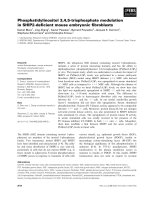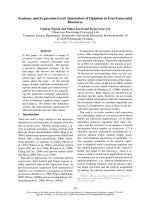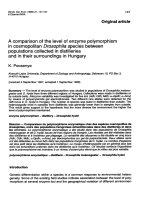computing fundamental btec level 5 hnd diploma in computing
Bạn đang xem bản rút gọn của tài liệu. Xem và tải ngay bản đầy đủ của tài liệu tại đây (6.58 MB, 36 trang )
<span class="text_page_counter">Trang 1</span><div class="page_container" data-page="1">
<b> ASSIGNMENT 1 FRONT SHEET</b>
<b>QualificationBTEC Level 5 HND Diploma in Computing</b>
<b>Unit number and title</b> Computing Fundamental
</div><span class="text_page_counter">Trang 3</span><div class="page_container" data-page="3"><b>❒ Summative Feedback: ❒ Resubmission Feedback:</b>
</div><span class="text_page_counter">Trang 5</span><div class="page_container" data-page="5"><b>Lecturer Signature:</b>
Table of contents
CONTENTSI. Introduction...3II. Body...4
</div><span class="text_page_counter">Trang 6</span><div class="page_container" data-page="6">1. Describe the functions of the different components of a conventional digital computer with the help of
a suitable block diagram...4
A. Mainboard: ...4
B. CPU: ...5
C. RAM: ...6
D. Hard Drive: ...6
</div><span class="text_page_counter">Trang 7</span><div class="page_container" data-page="7">E. GPU: ...6
F. Power supply: ...7
G. ROM: ...8
2. What is cache memory? Why is it necessary? Compare Cache and RAM? ...8
A. What is cache memory?...8
B. Why is it necessary?...9
C. Compare Cache and RAM?...9
3. State the role of the operating system in a computer system?...11
A. What is computer system ...11
B. The role of operating system in computer system ...11
III. Conclusion ...13
IV. References ...13
Table of figure
Figure 1: Computer system ...4Figure 2: Mainboard ...5
Figure 3: CPU ...5
</div><span class="text_page_counter">Trang 9</span><div class="page_container" data-page="9">Figure 10: Comparison Cache Memory vs RAM ...10Figure 11: Diagram of the role of the OS in a computer system ...12
</div><span class="text_page_counter">Trang 10</span><div class="page_container" data-page="10">I. Introdution
.
A computer is a programmable electronic device that accepts raw data as input and processes it with a set of instructions (a program) to produce the result as output. It renders output just after performing </div><span class="text_page_counter">Trang 11</span><div class="page_container" data-page="11">mathematical and logical operations and can save the output for future use. It can process numerical as well as non-numerical calculations. The term "computer" is derived from the Latin word "computare" which means to calculate.
. A computer is designed to execute applications and provides a variety of solutions through integratedhardware and software components. It works with the help of programs and represents the decimal numbers through a string of binary digits. It also has a memory that stores the data, programs, and resultof processing. The components of a computer such as machinery that includes wires, transistors, circuits,hard disk are called hardware. Whereas, the programs and data are called software.
. It is believed that the Analytical Engine was the first computer which was invented by Charles Babbage in 1837. It used punch cards as read-only memory. Charles Babbage is also known as the father of the computer.
II. Body
1. Describe the functions of the different components of a conventional digital computer with the help of a suitable block diagram
</div><span class="text_page_counter">Trang 13</span><div class="page_container" data-page="13"><i> Figure 1: Computer system </i>
<i>A. Mainboard: </i>
. Among the parts of a computer, the motherboard is the most important component. This part is also known as the mainboard, a place that holds all the important components of the machine.It will have slots to connect important components such as CPU, RAM, SSD, GPU, etc. In addition, the machine's
</div><span class="text_page_counter">Trang 14</span><div class="page_container" data-page="14">motherboard can also be attached directly to another part. Usually, the screen may refer to a type of metal semiconductor, also known as CMOS.
</div><span class="text_page_counter">Trang 15</span><div class="page_container" data-page="15">
Figure 2: Mainboard
<b>B. CPU: </b>
. The next important part mentioned is the GPU. This is an extremely important part of the computer. This is where the processor is located, a powerful GPU will help the machine optimize performance extremely well. On the market today, there are two popular types of CPU architecture: 32bit and 64bit. In particular, the two manufacturers that have almost a monopoly on the market are AMD and Intel. Simply put, the CPU is like the brain of your computer. All data access and processing operations on the machine will go through the CPU and then be displayed on the machine's screen.
</div><span class="text_page_counter">Trang 16</span><div class="page_container" data-page="16">Figure 3: CPU
</div><span class="text_page_counter">Trang 17</span><div class="page_container" data-page="17"><b>C. RAM:</b>
. One of the next components of a desktop computer is RAM. This is the abbreviation for Random Access Memory, which means random access memory. RAM will play the role of temporarily storing dataand information of the software and programs the machine is running. But this data information is only temporarily stored on RAM. When your device is powered off, all of this data will immediately be lost. Currently on the market there are many different types of RAM used such as DDR2, DDR3, DDR4. Most types of RAM, when used on a computer, will operate on the principle of dual-channel architecture. Helps divide processing data, and also helps increase data bandwidth for the machine.
<small> </small>
<small> </small>
Figure 4: RAM
</div><span class="text_page_counter">Trang 18</span><div class="page_container" data-page="18"><b>D. Hard Drive: </b>
. The device's hard drive will play the role of storing all the data on your device. It will include the device's software and operating system. On the market today, there are two most commonly used types of hard drives: HDD and SSD. Each type of hard drive will have different advantages and disadvantages,
</div><span class="text_page_counter">Trang 19</span><div class="page_container" data-page="19">depending on the user's needs. For HDD drives, the price will be quite cheap, but the read, write and information processing speed of the device will be slower than SSD drives.
</div><span class="text_page_counter">Trang 20</span><div class="page_container" data-page="20">graphics card when used will have higher parameters, serving the computer's graphic tasks well. than.<small> </small>
</div><span class="text_page_counter">Trang 21</span><div class="page_container" data-page="21">Figure 6: GPU
<b>F. Power supply: </b>
. The next component in the computer parts introduced is the PSU. A part that is probably not very familiar to people who are not tech savvy. PSU stands for power source. If this part is stable, your computer will be able to operate at full capacity. But if the machine's power source is not well guaranteed, the machine will not work well.
</div><span class="text_page_counter">Trang 22</span><div class="page_container" data-page="22">Figure 7: PSU<b><small> </small></b>
</div><span class="text_page_counter">Trang 23</span><div class="page_container" data-page="23"><b>G. ROM: </b>
. The next computer part to be introduced is the removable storage unit. Two common types of drives are DVD-ROM or Blu-ray. Both types are commonly known to have the ability to read and write machine data. This portable storage on the current market is no longer as popular as before. Because it has gradually been replaced by USB and memory card readers.
</div><span class="text_page_counter">Trang 24</span><div class="page_container" data-page="24">. <i>Cache memory is a special high speed primary memory. </i>
<i>Cache memory is important as it helps to increase the processing speed of CPU by making current </i>
program and data available to CPU at rapid rate.
Cache memory acts as a buffer between CPU and main memory by storing program or data needed in current execution as well as temporary data frequently needed in current computation.
</div><span class="text_page_counter">Trang 25</span><div class="page_container" data-page="25">Figure 9: Cache memory
<b> B. Why is it necessary? </b>
. The speed of the CPU is generally faster than main memory's speed. This results in slow down in processing speed of the CPU as main memory is not able to provide data and instruction as per CPU's processing rate. So a technique was developed of using a small, high speed cache memory and place it in between CPU and main memory.
Cache memory access time is almost close to CPU cycle time. Thus cache memory helps in increasing the performance of the computer.
Cache memory stores the portion of programs currently getting executed in CPU and any temporary dataneeded for computation.
It acts as a buffer between CPU and main memory.
This is the reason <i>cache memory is important and highly needed</i>.
</div><span class="text_page_counter">Trang 26</span><div class="page_container" data-page="26"><i>The above CPU and main memory speed disparity is popularly known as Von-neumann bottleneck.Thus cache memory is needed to eliminate this problem of speed disparity.</i>
<b>C. Compare Cache and RAM? </b>
. Both RAM and cache are volatile memory, meaning they need power to maintain the stored data and they will lose data, when the power is interrupted. RAM, short for random access memory, is an extremely fast computer memory which temporarily stores all the information your computer is actively using. Cache memory, on other hand, is a type of random-access memory that works between RAM and
</div><span class="text_page_counter">Trang 27</span><div class="page_container" data-page="27">the CPU, and that provides faster access to frequently used program instructions or data that the CPU is most likely to need next.
<b>. Cache is a small and very fast memory component located between the </b>
<b>computer’s primary memory (RAM) and its processor. Cache memory is sometimes called CPU memorybecause it is conceptually and physically located close to the CPU, which stores copies of data or instructions from frequently used main memory locations in order to provide high-speed access by the processor. RAM, on the other hand, is a computer’s short-term digital storage which stores data and programs actively used by the CPU. Cache is located closest to the CPU.</b>
</div><span class="text_page_counter">Trang 28</span><div class="page_container" data-page="28">
Figure 10: Comparsion Cache Memory vs RAM
</div><span class="text_page_counter">Trang 29</span><div class="page_container" data-page="29"><b>3. State the role of the operating system in a computer system? A. What is computer system </b>
. Is a collection of entities(hardware,software and liveware) that are designed to receive, process, manage and present information in a meaningful format.
<b>B. The role of operating system in computer system </b>
. The operating system (OS) is the software that manages the computer's hardware and software resources and provides common services for computer programs.
<b>. Managing applications</b>
<b>. One of the operating system’s functions that affect an operating system’s overall quality is running and</b>
managing applications. When you start an application, the CPU loads the application from the storage into RAM. In the early days of personal computing, single-tasking operating systems could run only one application at a time, which was often inconvenient. To switch between applications, you had to quit oneapplication before you could start the second.
<b>. Managing memory</b>
<b>. Programs would run very slowly if the operating system has to constantly access program instructions </b>
from their storage location on your computer’s hard disk. A buffer is needed to make the processing of instructions more fluid. Computers use a temporary storage medium, called memory, to function as this buffer. The computer’s operating system is responsible for managing memory. The operating system gives each running program its own portion of memory and attempt to keep the programs from interfering with each other’s use of memory
</div><span class="text_page_counter">Trang 30</span><div class="page_container" data-page="30">. <b>Handling input and output</b>
. Another function of the operating system is <i>handling input and output</i>, as well as enabling communication with input and output devices. Most operating systems come with drivers for popular input and output devices. Devices drivers are programs that contain specific information about a particular brand and model of input or output device. They enable communication between the operating system and the input and output components of a computer system. Printers, scanners, monitors, speakers and the mouse have drivers. Drivers that are not included with the operating system
</div><span class="text_page_counter">Trang 31</span><div class="page_container" data-page="31">software are supplied by the device manufacturers themselves and are often available on the manufacturers’ websites.
</div><span class="text_page_counter">Trang 32</span><div class="page_container" data-page="32">medicine and art. Although computers can cause some problems such as over-dependence or security issues, the benefits they bring far outweigh them. In general, computers are important tools that help improve the quality of our lives and work. In the future, we can expect constant progress in computer technology, opening up new possibilities and improving our lives for the better.
</div><span class="text_page_counter">Trang 33</span><div class="page_container" data-page="33"><b>IV. References </b>
1. Introduction what is computer:
. “What Is Computer - Javatpoint.” Www.javatpoint.com, Dec. 26AD, www.javatpoint.com/what-is-computer.
. nguyen, tuananh . “Các Bộ Phận Của Máy Tính? Chức Năng Của Từng Bộ Phận.” Công Nghệ Mới Nhất - Đánh Giá - Tư Vấn Thiết Bị Di Động, 25 July 2022,
1-6-dvd-rom-luu-tru-di-dong. Accessed 19 Sept. 2023.
didongviet.vn/dchannel/cac-bo-phan-cua-may-tinh/#ftoc-2-2. Body
. What is a Cache memory and Why is it necessary :
. tutorialsinhand.com. What Is Cache Memory? | Why Cache Memory Is Needed?
tutorialsinhand.com/tutorials/computer-organization-and-architecture-coa-tutorial/cache-memory/what-is-Compare Cache and RAM:
. experience, nature He believes everyone is a learning, et al. Difference between Cache and RAM |Difference Between. www.differencebetween.net/technology/difference-between-cache-and-ram/.
What is computer system:
. “The Computer System.” Peda.net, 2020,
</div><span class="text_page_counter">Trang 34</span><div class="page_container" data-page="34">The role of operating system in computer system:
. “Roles of an Operating System.” Introduction to Computing and Internet, 30 Jan. 2015, wouodl.wordpress.com/unit-1/1-3-operating-systems/roles-of-an-operating-system/.
</div>








